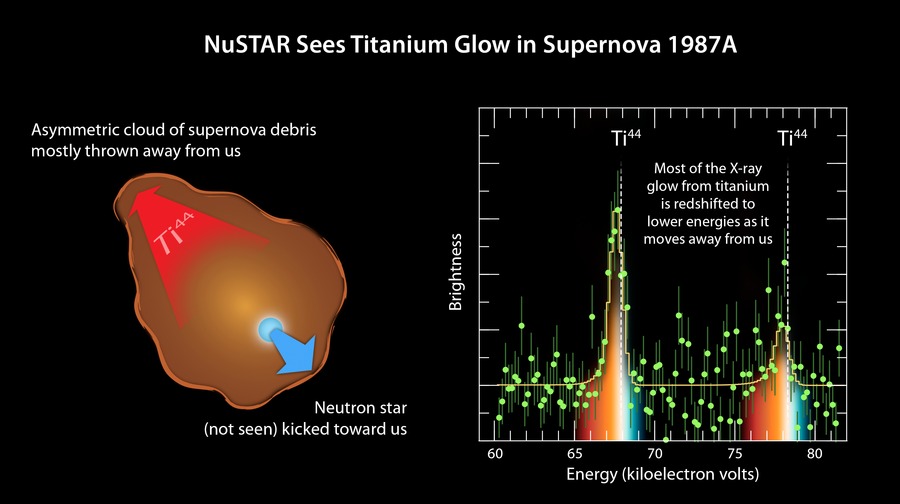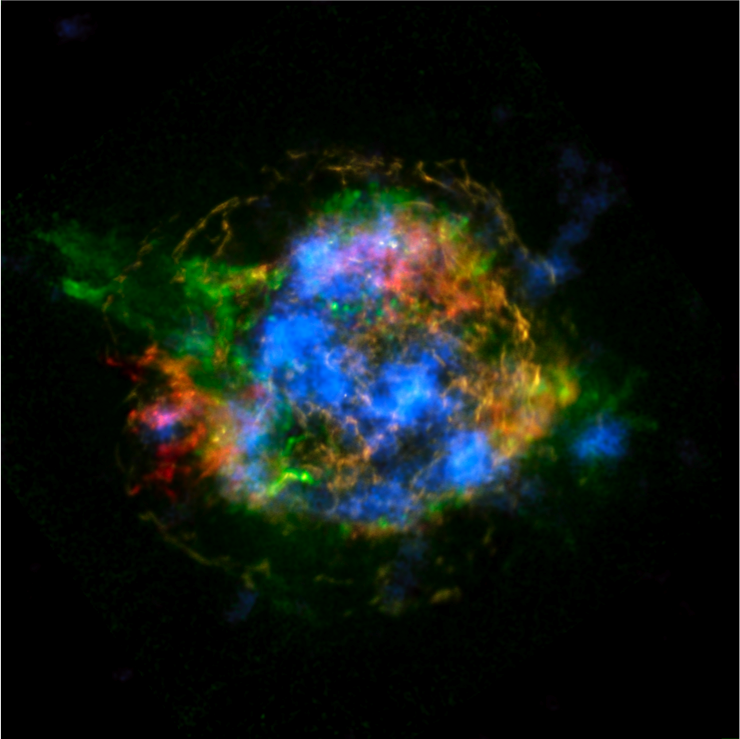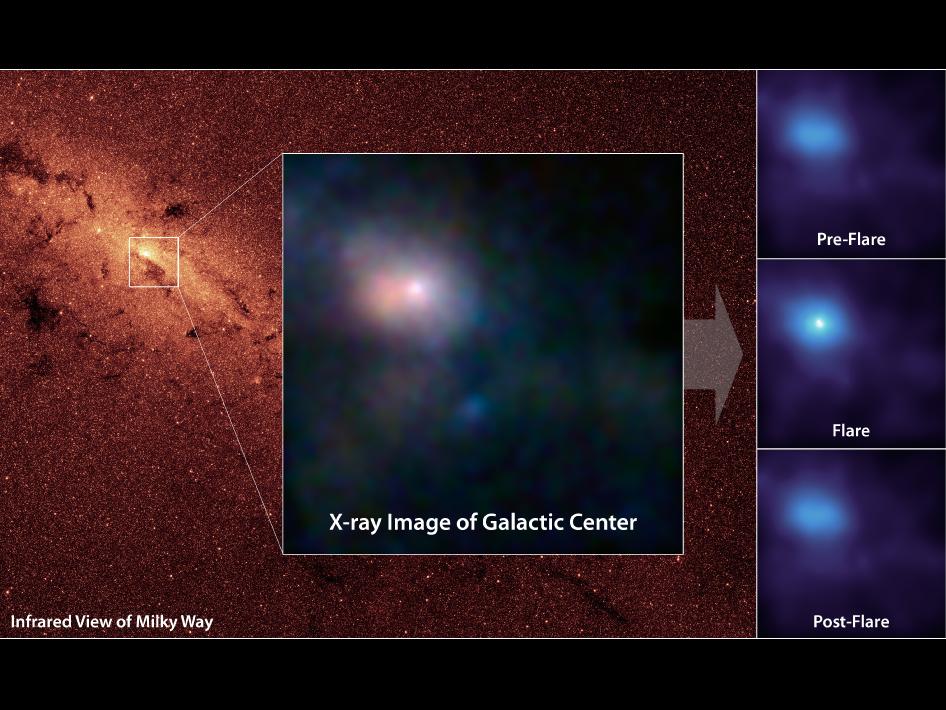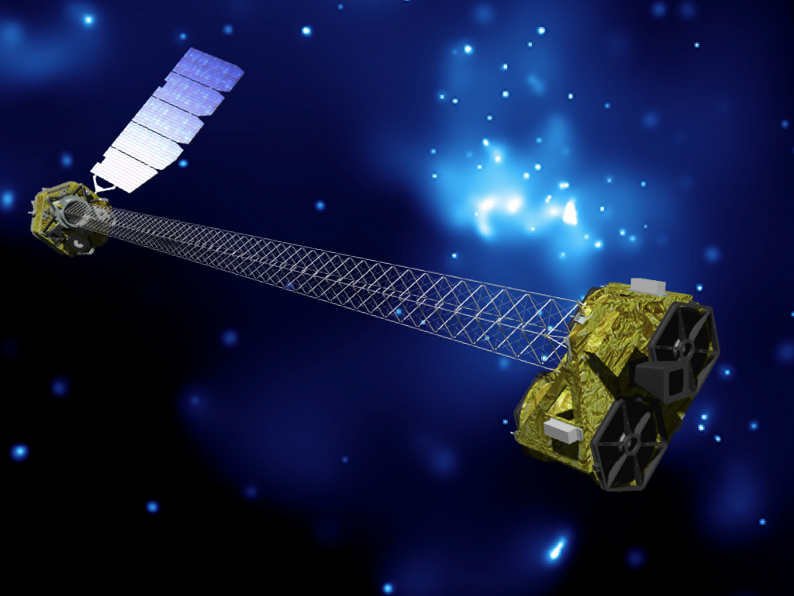
|
| Sep 17, 2015 | NuSTAR 7th Data Release at ASDC The NuSTAR 7th Data Release (DR7) is available from September 17, 2015 at ASDC. The NuSTAR DR7 constitutes the final primary mission data release and contains a total of 1750 data sets. All the NuSTAR public data at ASDC are fully integrated in the ASDC Multi-Mission Interactive Archive (MMIA). Through the MMIA the user can perform on-line analysis of all NuSTAR public observations, without the need to download any software, including the extraction of high-level scientific products (cleaned event files, sky images, energy spectra, light-curves, ARFs and RMFs). For more details on NuSTAR, see: https://nustar.ssdc.asi.it/ http://www.nustar.caltech.edu/ http://heasarc.gsfc.nasa.gov/docs/nustar/ |
| May 12, 2015 | Asymmetric explosion of SN1987A from 44Ti emission lines revealed with NuSTAR The NASA's high-energy X-ray observatory Nuclear Spectroscopic Telescope Array (NuSTAR) observations of the supernova 1987A (SN1987A) allowed to resolve the 67.87 and 78.32 kiloelectron volt emission lines from decay of 44Ti produced in the supernova explosion. NuSTAR data showed that these two lines are narrow and redshifted with a Doppler velocity of ~700 kilometers per second, probing direct evidence of large-scale asymmetry in the explosion. "Stars are spherical objects, but apparently the process by which they die causes their cores to be turbulent, boiling and sloshing around in the seconds before their demise," said Steve Boggs of the University of California, Berkeley, lead author of a new study on the findings, appearing in the May 8 issue of Science. "We are learning that this sloshing leads to asymmetrical explosions." "Titanium is produced in the very heart of the explosion, so it traces the shape of the engine driving the disassembly of the star," said Fiona Harrison, the principal investigator of NuSTAR at the California Institute of Technology in Pasadena. "By looking at the shift of the energy of the X-rays coming from titanium, the NuSTAR data revealed that, surprisingly, most of the material is moving away from us." Last year, NuSTAR created detailed 44Ti maps of another supernova remnant, called Cassiopeia A, also finding evidence of an asymmetrical explosion, though not to as great an extent as in 1987A. Together, these results suggest that lopsidedness is at the very root of core-collapse supernova. NuSTAR brought a new tool to the study of supernovae. Thanks to the observatory's sharp high-energy X-ray vision, it has made the most precise measurements of 44Ti yet. This radioactive material is produced at the core of a supernova, so it provides astronomers with a direct probe into the mechanisms of a detonating star. The Italian participation to NuSTAR includes the provision of the Malindi ground station (ASI), the ASI Science Data Center (ASDC), which contributes with the development of the NuSTARDAS software package and hosting an official mirror of the NuSTAR scientific public data archive, and a team of scientists of the Istituto Nazionale di Astrofisica (INAF) that actively collaborates on the primary scientific mission goals. The NuSTAR team at ASDC is composed by M. Perri (INAF archive scientist), S. Puccetti (INAF archive scientist) and P. Giommi (ASDC Responsible). For more details on NuSTAR, see: https://nustar.ssdc.asi.it http://www.nustar.caltech.edu  Right: 59-80 keV NuSTAR spectrum of SN1987A with detected 44Ti emission lines. The observations indicate that supernovae belonging to a class called Type II or core-collapse blast apart in a lopsided fashion, with the core of the star hurtling in one direction, and the ejected material mostly expanding the other way (see model diagram at left). [Credit: NASA/JPL-Caltech/UC Berkeley] |
| Mar 31, 2015 | NuSTAR 6th Data Release at ASDC The NuSTAR 6th Data Release is available from March 31, 2015 at ASDC. This new release contains 679 new data sets observed up to July 31, 2014. All the NuSTAR public data at ASDC are fully integrated in the ASDC Multi-Mission Interactive Archive (MMIA). Through the MMIA the user can perform on-line analysis of all NuSTAR public observations, without the need to download any software, including the extraction of high-level scientific products (cleaned event files, sky images, energy spectra, light-curves, ARFs and RMFs). For more details on NuSTAR, see: https://nustar.ssdc.asi.it/ http://www.nustar.caltech.edu/ http://heasarc.gsfc.nasa.gov/docs/nustar/ |
| Jan 20, 2015 | NuSTAR Principal Investigator receives the 2015 Bruno Rossi Prize We are pleased to report that the 2015 Bruno Rossi Prize of the High Energy Astrophysics Division (HEAD) of the American Astronomical Society has been awarded to the NuSTAR Principal Investigator Fiona Harrison for her "groundbreaking work on supernova remnants, neutron stars and black holes enabled by NuSTAR, the first satellite to focus X-rays at energies above 10 kiloelectron volts (keV)." The citation for the Rossi Prize, the top prize in high-energy astrophysics, notes that Harrison's "assembly and leadership of the extraordinary NuSTAR team has opened a new window on the Universe." "The exciting scientific results from NuSTAR are the culmination of close to two decades of work by a talented and dedicated team," said Harrison. "It is a privilege to work with them, and an honor to be recognized through the Rossi Prize." NuSTAR (Nuclear Spectroscopic Telescope Array) was launched in June 2012 under NASA's Small Explorer program. The primary science objectives are the study of the hottest, densest and most energetic phenomena in the universe, including the physics of massive black holes and collapsed stars, the explosion dynamics and nucleosynthesis in supernovae, and the particle acceleration in relativistic jets in Active Galactic Nuclei. The Italian participation to NuSTAR includes a) the provision of the Malindi ground station (ASI), b) the support of the ASI Science Data Center (ASDC), which has developed and maintains the NuSTARDAS data analysis software package and hosts an official mirror of the NuSTAR scientific data archive, and c) a team of scientists of the Istituto Nazionale di Astrofisica (INAF) and of Italian Universities to collaborate on the primary scientific mission goals. This is the fifth time that a space mission for which the ASDC plays an important role has been awarded a Rossi Prize, after BeppoSAX in 1998, Swift in 2007, Fermi in 2011 and AGILE in 2012.  Fiona A. Harrison, Benjamin M. Rosen Professor of Physics at Caltech. Credit: Lance Hayashida/Caltech |
| Sep 23, 2014 | NuSTAR 5th Data Release at ASDC The NuSTAR 5th Data Release is available from September 23, 2014 at ASDC. This new release contains 214 new data sets of 28 distinct targets observed up to June 30, 2014, including all the calibration observations of the Crab. All the NuSTAR public data at ASDC are fully integrated in the ASDC Multi-Mission Interactive Archive (MMIA). Through the MMIA the user can perform on-line analysis of all NuSTAR public observations, without the need to download any software, including the extraction of high-level scientific products (cleaned event files, sky images, energy spectra, light-curves, ARFs and RMFs). For more details on NuSTAR, see: https://nustar.ssdc.asi.it/ http://www.nustar.caltech.edu/ http://heasarc.gsfc.nasa.gov/docs/nustar/ |
| May 07, 2014 | NuSTAR 4th Data Release at ASDC The NuSTAR 4th Data Release is available from May 7, 2014 at ASDC. This new release contains 163 new data sets of 26 distinct targets observed up to December 31, 2013. All the NuSTAR public data at ASDC are fully integrated in the ASDC Multi-Mission Interactive Archive (MMIA). Through the MMIA the user can perform on-line analysis of all NuSTAR public observations, without the need to download any software, including the extraction of high-level scientific products (cleaned event files, sky images, energy spectra, light-curves, ARFs and RMFs). For more details on NuSTAR, see: https://nustar.ssdc.asi.it/ http://www.nustar.caltech.edu/ http://heasarc.gsfc.nasa.gov/docs/nustar/ |
| Feb 20, 2014 | NuSTAR creates the first map of 44Ti emission in Cassiopeia A The NASA's high-energy X-ray observatory Nuclear Spectroscopic Telescope Array (NuSTAR) has created the first map of radioactive element in the Cassiopeia A (Cas A) supernova remnant. The radioactive element is titanium-44, which has an unstable nucleus produced at the heart of the exploding star. The NuSTAR map of Cas A shows the titanium concentrated in clumps at the remnant's center, strongly suggesting that the exploding star literally sloshed around, re-energizing the stalled shock wave and allowing the star to finally blast off its outer layers. These results have been published in the February 20 issue of Nature. "Stars are spherical balls of gas, and so you might think that when they end their lives and explode, that explosion would look like a uniform ball expanding out with great power," said Fiona Harrison, the principal investigator of NuSTAR at the California Institute of Technology (Caltech) in Pasadena. "Our new results show how the explosion's heart, or engine, is distorted, possibly because the inner regions literally slosh around before detonating." The NuSTAR titanium-44 map also casts doubt on other models of supernova explosions, in which the star is rapidly rotating just before it dies and launches narrow streams of gas that drive the stellar blast. Though imprints of jets have been seen before around Cas A, it was not known if they were triggering the explosion. NuSTAR did not see the titanium, essentially the radioactive ash from the explosion, in narrow regions matching the jets, so the jets were not the explosive trigger. "With NuSTAR we have a new forensic tool to investigate the explosion," said the paper's lead author, Brian Grefenstette of Caltech. "Previously, it was hard to interpret what was going on in Cas A because the material that we could see only glows in X-rays when it's heated up. Now that we can see the radioactive material, which glows in X-rays no matter what, we are getting a more complete picture of what was going on at the core of the explosion." The Italian participation to NuSTAR includes the provision of the Malindi ground station (ASI), the ASI Science Data Center (ASDC), which contributes to the development of the NuSTARDAS software package and will host an official mirror of the NuSTAR scientific data archive, and a team of scientists of the Istituto Nazionale di Astrofisica (INAF) to collaborate on the primary scientific mission goals. The NuSTAR team at ASDC is composed by M. Perri (INAF archive scientist), S. Puccetti (INAF archive scientist) and P. Giommi (ASDC Responsible). For more details on NuSTAR, see: https://nustar.ssdc.asi.it/ http://www.nustar.caltech.edu/ http://heasarc.gsfc.nasa.gov/docs/nustar/  NuSTAR image of the Cas A supernova remnant superimposed with the NASA's Chandra orbiting telescope image. Blue shows NuSTAR's map of the distribution of titanium-44 produced in the core of the explosion 340 years ago, while red and green are X-ray emissions detected by Chandra of heated iron and silicon/magnesium, respectively. Image credit: NASA/JPL-Caltech/CXC/SAO. |
| Feb 06, 2014 | NuSTAR 3rd Data Release at ASDC The NuSTAR 3rd Data Release is available from February 6, 2014 at ASDC. This new release contains 104 new data sets of 21 distinct targets observed up to June 30, 2013. All the NuSTAR public data at ASDC are fully integrated in the ASDC Multi-Mission Interactive Archive (MMIA). Through the MMIA the user can perform on-line analysis of all NuSTAR public observations, without the need to download any software, including the extraction of high-level scientific products (cleaned event files, sky images, energy spectra, light-curves, ARFs and RMFs). A new version of the NuSTAR Data Analysis Software (NuSTARDAS v.1.3.1, developed by ASDC in collaboration with Caltech) is available within the new release of the HEASARC's HEASoft multi-mission software (v.6.15.1). An updated version (v.1.5) of the NuSTARDAS data analysis software guide is also available. For more details on NuSTAR, see: https://nustar.ssdc.asi.it/ http://www.nustar.caltech.edu/ http://heasarc.gsfc.nasa.gov/docs/nustar/ |
| Nov 25, 2013 | NuSTAR 2nd Data Release at ASDC The NuSTAR 2nd Data Release is available from November 25, 2013 at ASDC. This new release contains 72 new data sets of 15 distinct targets observed up to December 31, 2012. The total exposure time of this new data release is 538 ks. We are pleased to announce that all the NuSTAR public data at ASDC are now fully integrated in the ASDC Multi-Mission Interactive Archive (MMIA). Through the MMIA the user can perform on-line analysis of all NuSTAR public observations, without the need to download any software, including the extraction of high-level scientific products (cleaned event files, sky images, energy spectra, light-curves, ARFs and RMFs). A new version of the NuSTAR Data Analysis Software (NuSTARDAS v.1.3.0, developed by ASDC in collaboration with Caltech) is available within the new release of the HEASARC's HEASoft multi-mission software (v.6.15). An updated version of the NuSTARDAS data analysis software guide is also available. For more details on NuSTAR, see: https://nustar.ssdc.asi.it/ http://www.nustar.caltech.edu/ http://heasarc.gsfc.nasa.gov/docs/nustar/ |
| Aug 30, 2013 | NUSTAR ARCHIVE OPENING AT ASDC The NuSTAR data archive at the ASDC opened today, Aug 30, 2013, with an initial sample of 29 data sets from observations of a variety of objects. More data will be public in the coming months. The NuSTAR data analysis software ('nustardas', written by ASDC in collaboration with Caltech personnel) is available as a new sub-package in the HEASARC's FTOOLS/HEASoft multi-mission software as of the last release (FTOOLS v.6.14, 7 August 2013). Data analysis software guide is also available. For more details on NuSTAR, see https://nustar.ssdc.asi.it/ http://www.nustar.caltech.edu/ http://heasarc.gsfc.nasa.gov/docs/nustar/ |
| Oct 24, 2012 | NuSTAR Spots Flare From Milky Way's Black Hole The NASA's Nuclear Spectroscopic Telescope Array (NuSTAR) observatory has captured the first, focused view of the supermassive black hole located at the center of our galaxy (Sagittarius A*) in high-energy X-ray light. The observations were carried out in July and show the typically mild-mannered black hole during the middle of a flare-up. "We got lucky to have captured an outburst from the black hole during our observing campaign," said Fiona Harrison, the mission's principal investigator at the California Institute of Technology (Caltech) in Pasadena. "These data will help us better understand the gentle giant at the heart ofour galaxy and why it sometimes flares up for a few hours and then returns to slumber." Compared to other giant black holes at the centers of other galaxies, Sagittarius A* is relatively quiet. Active black holes tend to gobble up stars and other fuel around them. Sagittarius A* is thought only to nibble or not eat at all, a process that is not fully understood. When black holes consume fuel, whether a star, a gas cloud or even an asteroid, they erupt with extra energy. NuSTAR's X-ray telescopes picked up X-rays emitted by consumed matter being heated up to about 180 million degrees Fahrenheit (100 million degrees Celsius) and originating from regions where particles are boosted very close to the speed of light. Astronomers say these NuSTAR data, when combined with the simultaneous observations taken at other wavelengths, will help them better understand the physics of how black holes snack and grow in size. NASA Press release: http://www.nasa.gov/mission_pages/nustar/news/nustar20121023.html NuSTAR, launched June 13, is a Small Explorer mission led by Caltech and managed by NASA's Jet Propulsion Laboratory in Pasadena. The observatory carries the first focusing hard X-ray (3-80 keV) telescope to orbit, opening the hard X-ray sky for sensitive study for the first time. A full description of the mission can be found at the following link: http://www.nustar.caltech.edu/ The primary science objectives are the study of the evolution of massive black holes, of compact objects, of the nature of the massive black hole in the center of the Milky Way, of the explosion dynamics and nucleosynthesis in supernovae and of the nature of particle acceleration in relativistic jets in Active Galactic Nuclei. The Italian participation includes the provision of the Malindi ground station (ASI), the ASI Science Data Center (ASDC), which contributes to the development of the NuSTARDAS software package and will host an official mirror of the NuSTAR scientific data archive, and a team of scientists of the Istituto Nazionale di Astrofisica (INAF) to collaborate on the primary scientific mission goals. NuSTAR, launched June 13, is the only telescope capable of producing focused images of the highest-energy X-rays.  Figure caption: NuSTAR first, focused high-energy X-ray views of the area surrounding the supermassive black hole, called Sagittarius A*, at the center of our galaxy. In the main image, the brightest white dot is the hottest material located closest to the black hole, and the surrounding pinkish blob is hot gas, likely belonging to a nearby supernova remnant. The time series at right shows a flare caught by NuSTAR over an observing period of two days in July; the middle panel shows the peak of the flare, when the black hole was consuming and heating matter to temperatures up to 180 million degrees Fahrenheit (100 million degrees Celsius). The main image is composed of light seen at four different X-ray energies. Blue light represents energies of 10 to 30 kiloelectron volts (keV); green is 7 to 10 keV; and red is 3 to 7 keV. The time series shows light with energies of 3 to 30 keV (Image credit: NASA/JPL-Caltech). |
| June 28, 2012 | NuSTAR First Light! On June 28, the NASA Nuclear Spectroscopic Telescope Array (NuSTAR), obtained its first image of a celestial source, Cygnus X-1, a black hole in our galaxy that is siphoning gas off a giant-star companion. NuSTAR's mast, providing the telescope mirrors and detectors with the 10 meter distance needed to focus X-rays, was successfully deployed on June 21. "Today, we obtained the first-ever focused images of the high-energy X-ray universe," said Fiona Harrison, the mission's principal investigator at the California Institute of Technology in Pasadena, who first conceived of NuSTAR about 15 years ago. "It's like putting on a new pair of glasses and seeing aspects of the world around us clearly for the first time." NASA Press release: http://www.nasa.gov/mission_pages/nustar/news/nustar20120628.html  Figure caption: The inset image on the top right was taken with the INTEGRAL high-energy telescope; the image is 1 degree across, or twice the diameter of the moon. The bottom image shows NuSTAR's snapshot of the central part of that image. (Image credit: NASA/JPL-Caltech) |
| June 13, 2012 | NuSTAR successfully launched! On June 13, 2012 16:00 GMT the NASA NuSTAR mission was successfully launched aboard a Pegasus XL rocket from the Kwajalein Atoll, in the Marshall Islands, and deployed into a low-Earth, near-equatorial orbit. The solar arrays have been deployed, all comunications are working and the spacecraft is controlled. The drop location for the Pegasus was about 117 nautical miles south of Kwajalein, at an altitude of 39,000 feet over the Pacific Ocean and about 6.75 degrees above the equator. The Pegasus launch vehicle is built by Orbital Sciences Corporation and relies on a unique air-launch system with the rocket released from the "Stargazer" L-1011 aircraft. ASI Press release: http://www.asi.it/it/press_room/comunicati_stampa/nustar_alla_scoperta_dei_buchi_neri INAF Press release: http://www.media.inaf.it/2012/06/13/nustar-pronti-partenza-via/ The mission: The Nuclear Spectroscopic Telescope Array (NuSTAR) is a NASA Small Explorer mission that carries the first focusing hard X-ray (5-80 keV) telescope to orbit, opening the hard X-ray sky for sensitive study for the first time. A full description of the mission can be found at the following link: http://www.nustar.caltech.edu/ The primary science objectives are the study of the evolution of massive black holes, of compact objects, of the nature of the massive black hole in the center of the Milky Way, of the explosion dynamics and nucleosynthesis in supernovae and of the nature of particle acceleration in relativistic jets in Active Galactic Nuclei. The Italian participation includes the provision of the Malindi ground station (ASI), the ASI Science Data Center (ASDC) which contributes to the development of the NuSTARDAS software package and will host an official mirror of the NuSTAR scientific data archive and a team of scientists of the Istituto Nazionale di Astrofisica (INAF) to collaborate on the primary scientific mission goals.  Figure caption: Artist concept of NuSTAR fully extended after launch (Image credit: NASA/JPL-Caltech) |
| May 31, 2012 | Release of the final pre-flight NuSTAR Data Analysis Software (NuSTARDAS) On May 28, 2012 the ASDC has delivered to the NuSTAR Team at the California Institute of Technology (Caltech) the final pre-launch release of NuSTAR Data Analysis Software (NuSTARDAS, v. 0.5.0), the package to process the NuSTAR FITS formatted telemetry Level 1 data and generate calibrated Level 2 and Level 3 scientific products (event files, energy spectra, light-curves, sky images, exposure maps, ARFs, RMFs). The NuSTARDAS software has been developed at the ASDC in collaboration with the NuSTAR Team in Caltech, based on the Swift experience of the XRTDAS software development. The NuSTARDAS will be the official software for the NuSTAR scientific data reduction. It will be used at the NuSTAR Science Operation Center (SOC) in Caltech to generate the NuSTAR Science Team archive. The package will also be distributed to the users by the HEASARC as part of the HEASoft software. NuSTARDAS will be used at the NASA HEASARC Data Center to generate the public scientific archive. The NuSTAR data products will be compatible with widely used high-energy astronomy data analysis packages (e.g. XSELECT, XSPEC, XIMAGE, XRONOS). The mission: The Nuclear Spectroscopic Telescope Array (NuSTAR) is a NASA Small Explorer mission that will carry the first focusing hard X-ray (5-80 keV) telescope to orbit, opening the hard X-ray sky for sensitive study for the first time. The launch is scheduled for June 13th, 2012 and the primary mission is expected to last two years. The NuSTAR observatory scientific payload consists of two co-aligned X-ray telescopes and two CZT detectors that allow to extend the sensitivity to higher energies as compared to previous X-Ray missions. NuSTAR will use a deployable mast that will extend to achieve a 10-meter focal length. A full description of the mission can be found at the following link: http://www.nustar.caltech.edu The primary science objectives are the study of the evolution of massive black holes, of compact objects, of the nature of the massive black hole in the center of the Milky Way, of the explosion dynamics and nucleosynthesis in supernovae and of the nature of particle acceleration in relativistic jets in Active Galactic Nuclei. The Italian participation includes the provision of the Malindi ground station (ASI), the ASI Science Data Center (ASDC) which contributes to the development of the NuSTARDAS software package and will host an official mirror of the NuSTAR scientific data archive and a team of scientists of the Istituto Nazionale di Astrofisica (INAF) to collaborate on the primary scientific mission goals.  Figure caption: Artist concept of NuSTAR fully extended after launch (Image credit: NASA/JPL-Caltech) |
| October 12, 2011 | NuSTAR Data Analysis Software Build 2 delivery to Caltech The ASDC has delivered on October 7th the Build 2 of the NuSTAR Data Analysis Software (NuSTARDAS) package to the California Institute of Technology (Caltech) NuSTAR Team. This build incorporates six software modules that allow to fully calibrate the event files. Build 2 also includes a main script, the NuSTAR pipeline ('nupipeline'), running in sequence all the tasks for NuSTAR data processing. NuSTARDAS is a package to produce cleaned, calibrated event list files and standard high-level scientific products starting from FITS formatted telemetry data. It is developed at the ASDC in collaboration with Caltech and the first complete version, including also the data filtering and the extraction of high-level data products, is foreseen for January 2012. The NuSTARDAS software will be used to generate the NuSTAR scientific archive and it will be also distributed to the users as part of the HEASoft package maintained by the HEASARC. |